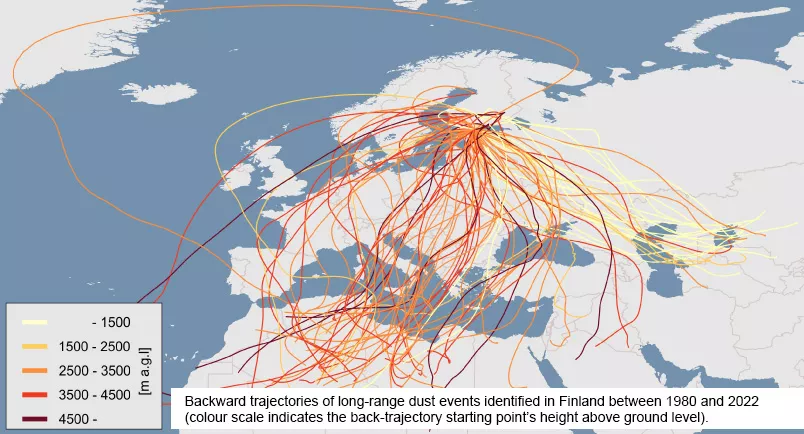Hungarian, Icelandic, and Finnish researchers led by Dr. György Varga, a senior research fellow at the Geographical Institute of the HUN-REN Research Centre for Astronomy and Earth Sciences (HUN-REN CSFK FTI), analysed dust storm events that reached the Finnish atmosphere from long distances between 1980 and 2022. They also identified signs of ongoing climate change, including the growing occurrence of south-north meridional atmospheric flows, attributed to the increased warming of higher geographical latitudes. The study presenting the results was published in the prestigious journal Environment International.

Through the investigations, researchers uncovered dust storm events during which particulate matter from the Sahara, the Aral-Caspian region, and the deserts of the Middle East reached the Finnish atmosphere. Based on model calculations, satellite measurements and images, as well as data from surface monitoring stations, among the episodes identified as potential dusty situations, events confirmed through calculations of air mass trajectories and traceable back to desert and semi-desert regions were added to the database. Thus, during the examined 43 years, a total of 86 long-distance dust storm events were identified in the atmosphere of Northern European countries, including 59 originating from Sahara areas, 22 from the dried-up bed of the Aral Sea and the desert and semi-desert regions of the Caspian Sea area, and 5 from the deserts of the Middle East.
While the emissions from these source areas, excluding the 'dried-up' Aral Sea, are not directly linked to human activity, researchers still emphasize that the effects of ongoing anthropogenic climate change can be identified in the time series and through synoptic meteorological backgrounds of individual episodes. The number of relatively scarce winter events has doubled since 2010, making these studies particularly significant, as local meteorologists have reported freezing rain during every identified winter occasion. Behind this phenomenon are warm upper-level inflows associated with dust storm events, similar to the Saharan dust influx, which was also one of the causes of the 2014 Normafa disaster.
These seasonal changes have evolved similarly in many other regions of Europe, including Hungary. It was, in fact, the frequency and intensity variations of Saharan dust transport observed in Hungary that initially drew the attention of researchers to Northern Europe. The underlying cause of these changes is the increased warming of the Arctic region and, consequently, the decreasing temperature difference between lower and higher latitudes. As a result, high-altitude jet streams lose their strength and become more meandering, adopting a wavier pattern. This, in turn, increases the likelihood of situations where south-north airflow predominates for extended periods, thereby raising the chances of dust reaching northern areas. These changes have also been detected in the case of Iceland.
Systematic, long-term research into these phenomena had not previously been conducted in the region of Finland. News and occasional case studies had only appeared in connection with specific events. Beyond its extended investigation period, the recent study was innovative because it focused not only on episodes originating from the dominant Saharan source areas. The Aral Sea region serves as an outstanding example of harmful human impacts. The waters of the Amu and Syr Darya rivers, once feeding the Earth's fourth-largest lake, were diverted for cotton irrigation, thus, the former lakebed is now occupied by one of the planet's most recent deserts, the Aralkum. A quarter of the identified dust storm events originated from this area. What surprised researchers even more was that on five occasions, dust from the Middle East – Syria, Saudi Arabia, and Iraq – also reached Finland.
Through the investigations, it has once again been confirmed that atmospheric processes changing due to climate change increasingly contribute to the occurrence of extreme weather events. However, the particulate matter reaching long distances is not just one symptom of it all. For example, when deposited on the snow and ice-covered regions of northern areas, it can also contribute to faster melting as the darker surface absorbs more heat, further amplifying the increased warming of higher latitudes. Since the start of the research, there have been two significant Saharan dust depositions in Finland. Consequently, the Finnish Meteorological Institute requested assistance from the public. In their call, they suggested that people melt the snow in saunas and then submit the samples, allowing the researchers to analyse as many dust samples as possible.
The research was carried out with the support of the NKFIH FK138692 and RRF-2.3.1-21-2021 projects, with the involvement of Hungarian, Finnish, and Icelandic researchers.
Publication:
Varga et al. Saharan, Aral-Caspian and Middle East dust travels to Finland (1980-2022). Environment International.
